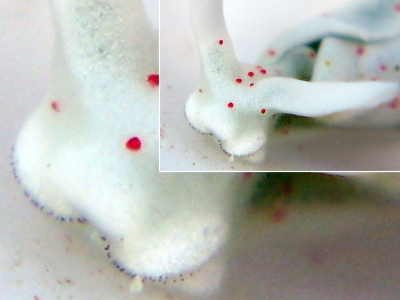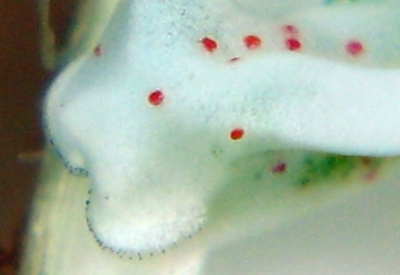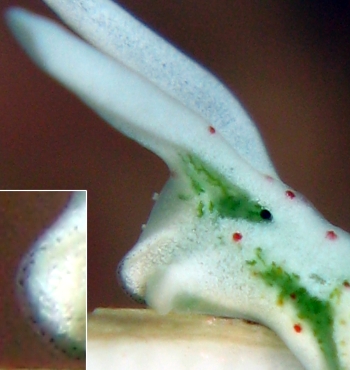Elysia timida from the French Mediterranean [3]
November 1, 2007
From: Dominique Horst


Hello Bill,
Here are more shots about another specimen of Elysia timida, which show details about their kind of teeth.
Locality: Antibes Cape, 7 m, France, Mediterranean sea, 27 October 2007. Length: 4 mm. Photographer: Dominique Horst.
Many thanks and kind regards,
Dom.
dominique.horst@wanadoo.fr
Horst, D., 2007 (Nov 1) Elysia timida from the French Mediterranean [3]. [Message in] Sea Slug Forum. Australian Museum, Sydney. Available from http://www.seaslugforum.net/find/21025
Dear Dom,
I guess when you say teeth you are talking about the black spots along the edge of the upper lip. They certainly look like little black spikes but in your side-on view in the photo alongside you can see that the edge of the lips are not white, but have a translucent-transparent edge, and the black specks are embedded in that.
Sacoglossans, like Elysia, are characterised by a special form of the mollusc radula in which there is a single row of teeth, each tooth usually being the shape of a knife blade or dagger, which they use for piercing a hole in the cell wall of their plant food so they can suck out the cell contents. The radula teeth of molluscs is on a tongue-like ribbon rather than part of a pair of biting jaws like us.
Which brings us back to the black things. I have no idea what they are. Having a look at one of Arnaldo Marin's papers (1993) in which he describes the development of the larvae, he says that newly hatched juveniles 'progressively develop black epidermal pigment which covers the head .. tip of rhinophore rudiments and the oral lobes...' I can't see any mention about when they lose this black pigment, but I suspect your mystery black specks are the remains of this black pigment. Hopefully someone can help us
-
Marin, A. and Ros, J. (1993) Ultrastructural and ecological aspects of the development of chloroplast retention in the sacoglossan gastropod Elysia timida. Journal of Molluscan Studies 59: 95-104.
-
Marin, A. and Ros, J. D. ( 1989) The chloroplast-animal association in four Iberian Sacoglossan Opisthobranchs: Elysia timida, Elysia translucens, Thuridilla hopei and Bosellia mimetica. Scientia Marina 53: 429-440.
Marin, A. and Ros, J. D. ( 1992) Dynamics of a peculiar plant-herbivore relationship: the phtosynthetic ascoglossan Elysia timida and the chlorophycean Acetabularia acetabulum. Marine Biology 112: 677-682, Figs 1-10.
Best wishes,
Bill Rudman
Related messages
-
Elysia timida from the French Mediterranean [2]
From: Dominique Horst, November 1, 2007 -
Elysia timida from Antibes, Mediterranean Sea
From: Dominique Horst, October 31, 2007 -
Elysia timida from Fethiye Bay, Turkey.
From: Ant Turkmen, July 14, 2004 -
Re: Solar Powered Species - Elysia timida
From: Levent Cavas, February 21, 2004 -
Solar Powered Species - Elysia timida
From: Ant Turkmen, February 20, 2004 -
Elysia timida from Turkey
From: Ferda Büyükbaykal, September 12, 2003 -
Elysia timida from Turkey
From: Orhan Aytur, April 24, 2003 -
Elysia timida from French Mediterranean
From: Marina Poddubetskaia, August 2, 2002 -
Elysia timida feeding
From: Patrick Heurtaux , April 23, 2001 -
Elysia timida mating
From: Erwin Koehler, April 11, 2001 -
Photos of Elysia timida
From: Bill Rudman, April 9, 2001
